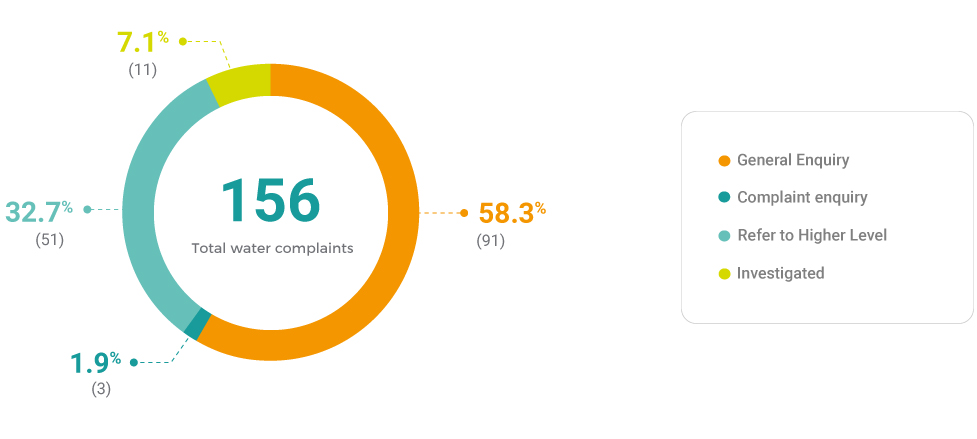-
Home
-
Publications and submissions
-
Reports
-
EWON Insights
-
EWON Insights Jul-Sep 2020
- Water complaints and case studies
Water complaints and case studies
The number of water complaints received this quarter (156) decreased by 18.3% compared to last quarter (191), and by 32.8% compared to the corresponding period in 2019 (232).
High bills continue to be the biggest issue for water customers who contact us. Other complaints about water providers relate to customer service and the maintenance of network assets, as seen in Table 4 below.
Table 4 — Water top 5 issues Jul to Sep 2020, including previous quarters
| Primary and secondary issue | Jul-Sep 20 | Apr-Jun 20 | Jan-Mar 20 | Oct-Dec 19 | Jul-Sep 19 |
|---|---|---|---|---|---|
| Billing > High > Disputed | 34 | 40 | 44 | 42 | 50 |
| General > Energy/water | 32 | 30 | 32 | 30 | 31 |
| Customer service > Failure to respond | 20 | 26 | 28 | 33 | 29 |
| Customer service > poor service | 13 | 25 | 33 | 38 | 34 |
| Land > network assets > maintenance | 12 | 17 | 14 | 27 | 18 |
The graph and table below show the breakdown of water complaints during the quarter,

Table 5 - Complaint breakdown - Water - Jul-Sep 2020
| Complaint type | Number of complaints | Total % |
|---|---|---|
| General enquiry | 91 | 58.3% |
| Complaint enquiry | 3 | 1.9% |
| Refer to Higher Level | 51 | 32.7% |
| Investigated | 11 | 7.1% |
| Total | 156 | 100% |
High bills and affordability
This case study highlights the complexity of high bill complaints, which involve the interaction of bills, vacant premises and the importance of financial assistance.
Case study
A customer complained to EWON that her water bills were higher than expected. She told us that the property had been vacant for two years, yet she had received a six-monthly bill of $446 for the period 17 December 2019 to 17 June 2020. She mentioned that someone had squatted at the premises for three days during the billing period and was then evicted. She also told us she was struggling to pay her bills and wanted to clarify that only Service Availability Charges were included in the billing total.
An EWON investigation established that there had only been 1 kilolitre of water consumed at the supply address since 2017 and the customer had been billed for the consumption and for Sewer and Water Availability Charges for the period 12 December 2019 to 17 June 2020. We explained that customers will always be billed for supply charges, regardless of consumption. After we spoke to the provider, it offered a payment plan through its customer assistance program, with fortnightly payments and the option of making payments for either a 24 or 36-month period.
Similar complaints received by EWON
We have received similar complaints from other customers. Some customers made enquiries about bills that included periods when the premises were vacant. Some customers also told us that they were struggling to afford to pay their bills and have lost their jobs due to COVID-19, so wanted to set up a payment plan. These cases highlight the importance of customers being aware of assistance programs and payment plans which may assist with their financial situations.
Unknown causes of overflows
It can be difficult to identify and fix causes for overflows, which can become an ongoing problem for customers.
Case study
A customer advised EWON that he had lived at his premises for 17 years and had been experiencing sewage overflows about two to three times per year. Whenever this occurred, he contacted his water provider to flush out the line. In June 2020, the provider sent an inspection team to examine soil samples to determine if the overflow was entering a creek. He was advised that the sewage was blocked at the lowest point on the street (at the customer’s property), however the team could not determine what the specific issue was. The customer was told the complaint would be escalated; however the provider did not advise of any further action. He was concerned that the problem needed to be fixed properly to prevent it from occurring again. We referred the matter to the provider for resolution at a higher level with the customer’s acceptance knowing that he could return to EWON if he was unhappy with the outcome.
Similar complaints received by EWON
We have received similar complaints from customers about overflows or leaks, with unknown causes, which require an examination of the infrastructure. This highlights the need for customers to be aware of the steps that they can take once overflows or leaks are identified, to fix the problem and prevent any future overflows or leaks.

